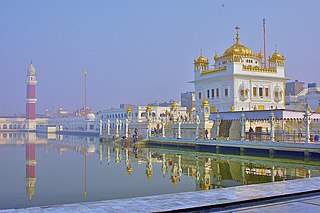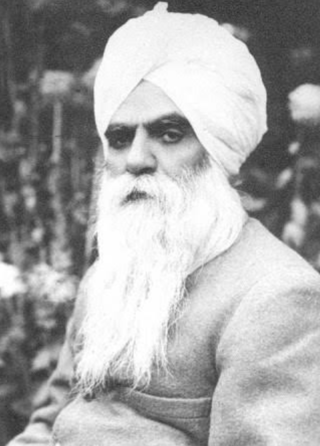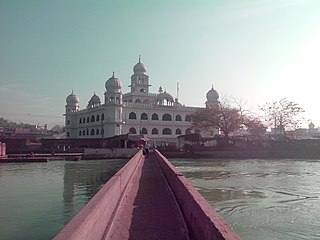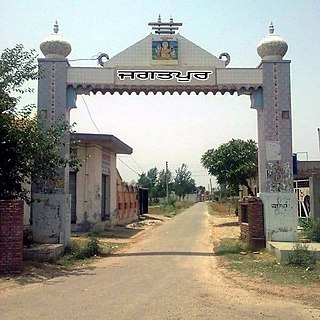| Part of a series on |
| Punjabis |
|---|
 |
 Punjab portal |
A Shaheed Shrine is a building constructed to commemorate and show respect to a saint [1] and forms part of Punjabi folk religion in the Punjab region.
| Part of a series on |
| Punjabis |
|---|
 |
 Punjab portal |
A Shaheed Shrine is a building constructed to commemorate and show respect to a saint [1] and forms part of Punjabi folk religion in the Punjab region.
In Punjabi folk cosmology, the universe is divided into three realms: [2]
| English | Punjabi | Inhabitants |
|---|---|---|
| Sky | Akash | Dev Lok (Angels) |
| Earth | Dharti | Matlok (Humans) |
| Underworld | Naglok | Nagas (Serpents) |
Devlok is the realm of the gods, saints and ancestors, existing in akash, the sky.
A Shaheed can be martyred and hence achieve sainthood or can become a saint in the afterlife.
Although not part of organised religion, Shaheed Shrines only form part of Sikh and Muslim folk religion. However, such shrines are respected by all faiths.
Sikhs prefer to use the term Shaheed "jaggah" (but sometimes also use the term "smadh") whereas Muslims also use the term dargah or mazaar for such shrines if the shrine is near a grave. Muslim Shaheed Shrines typically represent Sufi saints.
The Hindus equivalent of Shaheeds are Siddhs of the Siddha tradition. Siddha shrines are either referred to as Mandirs or Samadhs.
Saint worship in shrines is common in the Punjab region. [3] People of all faiths attend and venerate shrines in honour of saints.
These shrines represent sources of power (barkat) to the common people and are open to people from all religious persuasions. The shrines can be at the final resting places of the saints (dargahs) or ‘memorial shrines’. [4] These memorial shrines have evolved into a distinct form of ‘saint worship’. [5] These shrines represent inter-communal dialogue and a distinct form of cultural practice of saint veneration.
Shrines can be local, such as the shrine of Bhagat Baba Kalu [6] and Baba Nihal Singh Ji, [7] or they can be popular across a larger area forming part of folklore, such as the shrines of Sakhi Sarwar, also known as Baba Lakhadata whose larger central shrine is in Sakhi Sarwar of Dera Ghazi Khan District, Pakistan and the smaller shrine in Una, Himachal Pradesh, India. [8] Other popular shrines include those of Gugga Ji and Khawaja Khizr.

A dargah is a shrine or tomb built over the grave of a revered religious figure, often a Sufi saint or dervish. Sufis often visit the shrine for ziyarat, a term associated with religious visits and "pilgrimages". Dargahs are often associated with Sufi eating and meeting rooms and hostels, called khanqah or hospices. They usually include a mosque, meeting rooms, Islamic religious schools (madrassas), residences for a teacher or caretaker, hospitals, and other buildings for community purposes.

Tarn Taran Sahib is a city in the Majha region of the state of Punjab, in northern India. It is the district headquarters and hosts the municipal council of Tarn Taran district. Gurdwara Sri Tarn Taran Sahib, a prominent Sikh shrine is located in the central part of the city.

Farīd al-Dīn Masʿūd Ganj-i-Shakar was a 13th-century Punjabi Sunni Muslim preacher and mystic, who was one of the most revered and distinguished Muslim mystics of the medieval period. He is known reverentially as Bābā Farīd or Shaikh Farīd by Muslims, Hindus and Sikhs of the Punjab Region, or simply as Farīduddīn Ganjshakar.

Majha is a region located in the central parts of the historical Punjab region split between India and Pakistan. It extends north from the right banks of the river Beas, and reaches as far north as the river Jhelum. People of the Majha region are given the demonym "Mājhī" or "Majhail". Most inhabitants of the region speak the Majhi dialect, which is the basis of the standard register of the Punjabi language. The most populous city in the area is Lahore on the Pakistani side, and Amritsar on the Indian side of the border.

Pakpattan, often referred to as Pākpattan Sharīf, is the capital city of the Pakpattan District, located in Punjab province of Pakistan. It is the 48th largest city of Pakistan by population according to the 2017 census. . Pakpattan is the seat of Pakistan's Chisti order of Sufism, and is a major pilgrimage destination on account of the shrine of Fariduddin Ganjshakar, the renowned Punjabi poet and Sufi saint commonly referred to as Baba Farid. The annual urs fair in his honour draws an estimated 2 million visitors to the town.

The Janamsakhis, are legendary biographies of Guru Nanak – the founder of Sikhism. Popular in the Sikh history, these texts are considered by scholars as imaginary hagiographies of his life story, full of miracles and travels, built on a Sikh oral tradition and some historical facts. The first Janamsakhis were composed between 50 and 80 years after his death. Many more were written in the 17th and 18th century. The largest Guru Nanak Prakash, with about 9,700 verses, was written in the early 19th century.

Baba Deep Singh is revered among Sikhs as one of the most hallowed martyrs in Sikhism. He is remembered for his sacrifice and devotion to the teachings of the Sikh Gurus. Baba Deep Singh was the first head of Misl Shaheedan Tarna Dal – an order of the Khalsa military established by Nawab Kapur Singh, the then head of Sharomani Panth Akali Buddha Dal. The Damdami Taksal also state that he was the first head of their order.

Bhai Vir Singh was an Indian poet, scholar, and theologian of the Sikh revival movement, playing an important part in the renewal of Punjabi literary tradition. Singh's contributions were so important and influential that he became canonized as Bhai, an honorific often given to those who could be considered a saint of the Sikh faith.
Sakhi Sarwar is a town in Dera Ghazi Khan District, Punjab, Pakistan. It is named after a Muslim Sufi saint Syed Ahmad Sultan, also known as Sakhi Sarwar, whose tomb is situated in the vicinity.

Bakarpur is a large village in Mohali district in the Indian state of Punjab. Bakarpur had previously been shifted from Ambala district to Rupnagar district on formation of Haryana state on 1 November 1966. Further, on formation of Mohali district, it had been shifted to it in 2006. Now it is getting developed fast like a town. There is a large market, government senior secondary school, Primary health centre, veterinary hospital, IndusInd Bank, HDFC Bank and Punjab Gramin Bank. In 2009/10 large area of cultivated land of Bakarpur was acquired by the Greater Mohali Area Development Authority (GMADA) for construction of a 200-foot-wide (61 m) road from Mohali City to Mohali Airport which is also being connected to the Zirakpur-Patiala Road. Now the GMADA is going to develop new sectors along with this road and the same has been named as Aerocity. In year 2010 residential plots have been allotted by GMADA to the public by draw of lots. This village is on the newly created Mohali airport road.

Lakhpur is a village near Sahni (Lakhpur-Sahni), Tehsil Phagwara, Kapurthala district, in Punjab, India.

Kiratpur also known as Kiratpur Sahib is a town in Rupnagar district, Punjab, India. The town is the location of the Gurdwara Patal Puri where many Sikhs take ashes of their deceased.

Talhan is a village in Jalandhar district, near the Jalandhar Cantonment, in Punjab, India.

Naugaja Peer was a saint whose height was 9 "gaj" which in Indian metric units equals 8 meters and 36 inches or 27 feet. An explanation is that peer was likely surrounded by his nine men making 27 feet rectangular border to save him His name was Syed Ibrahim Badshah, who is believed to ensure safe journeys and completion of all works in time.

Syed Ahmad Sultan, popularly known as Sakhi Sarwar, was a 12th-century Sufi saint of the Punjab region.
Roshni Mela(festival of lights) is held in Jagraon. The fair is held at the mazar of Peer Baba Mohkumdeen and lasts for three days. Thousands of people from Punjab, Haryana, Uttar Pradesh, Himachal Pradesh and other neighbouring states visit the place, light an earthen lamp at the mazar and pray.

Jagatpur is a village in Shaheed Bhagat Singh Nagar district of Punjab State, India. It is 2.2 kilometres (1.4 mi) away from postal head office Mukandpur, 9.3 kilometres (5.8 mi) from Banga, 12 kilometres (7.5 mi) from district headquarters Shaheed Bhagat Singh Nagar and 113 kilometres (70 mi) from state capital Chandigarh. The village is administrated by Sarpanch an elected representative of the village.
Punjabis are the majority ethnic group in Pakistan. They celebrate a number of religious and cultural festivals:

Baba Ratan Hindi was a legendary person, alleged to be one of the non-Arab companions of the Islamic prophet Muhammad. Baba was born in Punjab, he was a trader who used to take goods from India to Arabia. There is also a dargah named after him, the Haji Ratan Dargah in Bathinda. People migrated to Pakistan from India during partition of 1947 still remember him.
Folk practices prevalent in Punjab incorporate local mysticism and refers to the beliefs and practices strictly indigenous to the Punjabi people, of the Punjab region including ancestral worship, veneration of saints, and local festivals. There are many shrines in Punjab which represent the folk religion of the Punjab region which is a discourse between different organised religions. These shrines represent inter-communal dialogue and a distinct form of cultural practice of saint veneration.